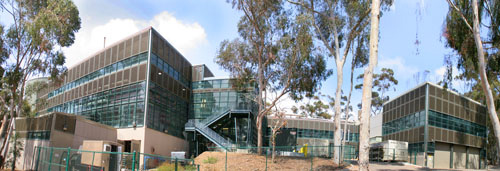
More Power To You: Ensuring a Reliable, Safe and Secure Supply of Energy at UC San Diego
By:
- Laura Margoni
Published Date
By:
- Laura Margoni
Share This:
Article Content
Electricity, like good health, is one of those things you often take for granted…until you don’t have it anymore. At the University of California, San Diego, ensuring a steady supply of electricity in a sustainable and cost-effective way has been a priority for years. Already recognized for its award-winning energy efficiency programs, UC San Diego is taking steps to enhance its electrical system, making it even more reliable, safe and secure.

UC San Diego's highly efficient natural gas-fired cogeneration power plant will now have emergency restart capabilities.
“We serve a campus community of more than 45,000 students, faculty and staff and we take their energy needs very seriously,” said Gary Matthews, vice chancellor of Resource Management and Planning, who oversees sustainability and facilities management. “Our ultimate goal is to ensure that any potential power outages have a minimal effect, if any, on campus operations. This has become even more important in the wake of the recent closure of the San Onofre Nuclear Generating Station.”
At UC San Diego, the key to “keeping the lights on” is the campus’ microgrid. Considered one of the world’s most advanced microgrids, the microgrid generates more than 90 percent of the electricity used on campus annually, and saves the campus more than $850,000 per month in power costs. A microgrid is a small-scale version of a traditional large power grid that draws energy from clean sources such as wind and solar power, as well as from conventional technology. It can be connected to a larger electric grid, but can also work independently.
It is this ability to work independently, called “islanding,” that helps UC San Diego ensure grid reliability and energy independence. Among the many recent and ongoing improvements to the campus electrical utility system is the installation of an automatic substation control system. In the event of a regional power outage, this control system can disconnect the microgrid from the larger San Diego Gas & Electric (SDG&E) power grid, effectively turning the campus into a self-sustaining energy island.
According to John Dilliott, UC San Diego energy and utilities manager, there is one caveat to this, however. The microgrid can only island when the energy demand on campus is equal to or lesser than what the campus can generate. Currently, the campus’ power generation assets include a cogeneration facility, fuel cell and rooftop solar panels. Together, these assets provide about 75 percent of the campus’ peak power demand, with the remainder purchased from the SDG&E grid.
“When the campus attempts to island, if demand is even one kilowatt over what we can supply, the whole network will shut down,” he said. “The possibility of a campus disturbance is greatest when the grid is most vulnerable during the midday heat.”
To prevent this from happening, the campus is testing more effective ways to shed electricity loads and shift energy usage. One of the most effective responses is to automatically set thermostats in offices and labs to “unoccupied” mode, keeping the temperature higher and reducing the amount of cooling energy needed. In the event of a regional or statewide electrical alert, the campus community will also be notified and asked to conserve power as much as possible by turning off unnecessary lights and equipment.
“When it comes to power conservation, every little bit you can do to save electricity really helps,” added Dilliott.
In addition to installing the automatic substation control system, which enables the campus microgrid to island, UC San Diego is pursuing additional power projects that will enhance the ability to respond to any interruptions in normal electrical power supply. These projects include:
- Cogeneration Plant – Addition of emergency restart capabilities. In the event of a power interruption, these improvements will enable a more rapid start of the Central Utilities Plant turbines.
- Paralleling Emergency Automatic Transfer Switches – The campus is at the greatest risk for loss of power when the campus’ demand, or load, is greater than our generation capacity. Using automatic transfer switches gives us the ability to shift the load from the grid to our emergency generators within 10 seconds, thereby preserving the campus’ base power generation capacity.
- PMU Monitoring System Installation – Phasor Measurement Units (PMU), also called synchrophasors, will monitor the “health” of the SDG&E grid and provide, potentially, up to a 10 minute warning if the SDG&E grid becomes unstable. The system also links to the automatic substation control system and the paralleling emergency automatic transfer switches. This will help avoid the potential effects of a SDG&E grid collapse by enabling the campus to island as well as shift load from the grid to emergency generators.
- Resistive Load Bank on Fuel Cell System – The 2.8 megawatt fuel cell takes approximately eight hours to restart if it trips offline. The resistive load bank will allow it to be restarted quickly if a loss of power occurs.
The campus is also engaging in several high-voltage system renewal projects that help ensure a reliable supply of energy. All improvement projects are expected to be completed by summer 2014.
For more information on the campus utility projects visit http://blink.ucsd.edu/facilities/management/maintenance/utilities.html. For information on sustainability at UC San Diego visit http://sustainability.ucsd.edu.
Share This:
You May Also Like
Stay in the Know
Keep up with all the latest from UC San Diego. Subscribe to the newsletter today.


